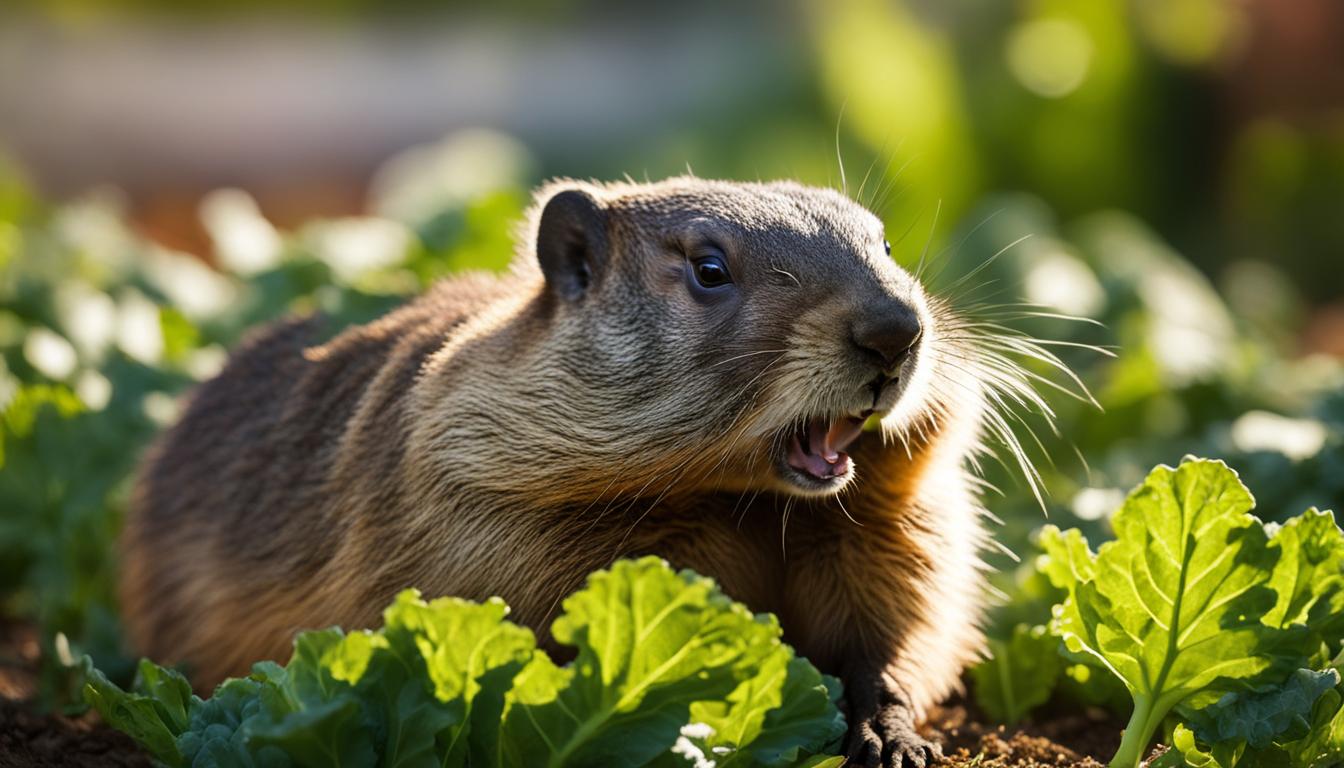Groundhogs, also known as woodchucks, are herbivorous animals that belong to the marmot family. They have a reputation for raiding gardens and feasting on a variety of vegetables, but do they eat kale?
Let’s explore the eating habits and diet of groundhogs to find out if kale is on their menu.
Groundhogs are notorious for their love of vegetables. They enjoy munching on plants, roots, fruits, and yes, even kale.
These furry garden intruders have a wide range of food preferences, including broccoli, cabbage, celery, lettuce, peas, and squash.
So, if you have a vegetable garden with kale, it’s possible that groundhogs may pay you a visit.
Key Takeaways:
- Groundhogs, also known as woodchucks, are herbivorous animals. They enjoy feeding on a variety of vegetables, including kale.
- Some of the groundhog’s favorite vegetables include broccoli, cabbage, celery, lettuce, peas, and squash.
- If you have a vegetable garden with kale, there is a possibility that groundhogs may be attracted to it.
- Understanding groundhog eating habits and preferences can help you protect your garden and coexist peacefully with these adorable critters.
- Implementing preventative measures, such as fencing and using natural repellents, can help deter groundhogs from causing damage to your garden.
Vegetables That Attract Groundhogs
Groundhogs have a diverse diet and are attracted to a variety of vegetables that are commonly found in gardens.
These vegetables provide them with the necessary nutrition and taste that they seek. Some of the vegetables that groundhogs find particularly enticing include carrots, lettuce, broccoli, cauliflower, Brussels sprouts, cabbage, spinach, collard greens, kale, beet greens, Swiss chard, peas, green beans, sweet potatoes, squash, zucchini, pumpkin, corn on the cob, radishes, and turnips.
These vegetables are highly palatable to groundhogs and can become easy targets if not protected properly.
To effectively manage groundhog intrusion, it is crucial to understand their preferences when it comes to food.
By identifying the vegetables they are most attracted to, you can take proactive measures to safeguard your garden and minimize the risk of damage.
Table: Vegetables That Attract Groundhogs
| Vegetable | Groundhog Attraction Level |
|---|---|
| Carrots | High |
| Lettuce | High |
| Broccoli | High |
| Cauliflower | High |
| Brussels Sprouts | High |
| Cabbage | High |
| Spinach | High |
| Collard Greens | High |
| Kale | High |
| Beet Greens | High |
| Swiss Chard | High |
| Peas | High |
| Green Beans | High |
| Sweet Potatoes | High |
| Squash | High |
| Zucchini | High |
| Pumpkin | High |
| Corn on the Cob | High |
| Radishes | High |
| Turnips | High |
It is important to note that the attractiveness of these vegetables may vary depending on the specific groundhog population in your area.
Observing their feeding patterns and preferences can provide valuable insights into the selection of vegetables to grow and protect.
Groundhog-Proof Vegetables
When it comes to protecting your garden from groundhog invasions, choosing the right vegetables can make all the difference.
Certain vegetables are less likely to attract groundhogs and can be considered “groundhog-proof.” These veggies possess characteristics that deter groundhogs and can help safeguard your harvest.
Strong-Smelling Vegetables
Groundhogs have a sensitive sense of smell, so planting vegetables with strong aromas can act as a natural repellent.
Garlic, onions, shallots, leeks, and chives are excellent choices that can help keep groundhogs at bay.
These pungent vegetables not only add flavor to your dishes but also discourage groundhog foraging.
Avoiding Leafy Greens
Groundhogs tend to avoid leafy greens like peppers, eggplants, and tomatoes. Incorporating these vegetables into your garden can help minimize groundhog interest.
These plants not only provide a delicious harvest for you but also reduce the risk of groundhog damage in your garden.
Fencing off the perimeter of the garden and burying it underground can also help protect the roots of vegetables from groundhog damage.
This physical barrier creates a boundary that groundhogs are less likely to breach.
Coexisting with Groundhogs in Your Garden
When it comes to dealing with groundhogs in your garden, finding a balance between human needs and wildlife needs is essential.
These furry creatures can be a nuisance, but they also play an important role in the ecosystem. Here are some tips on how to coexist peacefully with groundhogs while protecting your garden:
1. Fencing off your garden:
Installing a sturdy fence around your garden can help keep groundhogs out. Opt for a fence that is at least 3 feet high, burying it about a foot below the surface to prevent them from burrowing underneath.
Make sure the fence has a secure gate and is made of materials that groundhogs cannot easily chew through.
2. Providing designated feeding areas:
Consider setting up a separate feeding area away from your garden, where groundhogs can safely enjoy some of their favorite foods.
By offering them a designated spot with vegetables or fruits, you can help divert their attention away from your crops.
3. Using natural deterrents:
There are several natural repellents that can help discourage groundhogs from causing damage.
Sprinkling Epsom salts around the perimeter of your garden can create an unpleasant environment for them.
Aromatic herbs, such as mint or lavender, can also act as natural repellents. Some gardeners swear by scattering human hair around the garden, as groundhogs dislike the scent of humans.
By following these tips and implementing preventive measures, you can protect your garden while respecting the needs of groundhogs.
Remember, coexistence is key, and removing groundhogs should only be considered as a last resort.
| Groundhog Coexistence Tips | |
|---|---|
| Fence off your garden | Installing a sturdy fence around your garden can help keep groundhogs out. |
| Provide designated feeding areas | Set up a separate feeding area away from your garden to divert groundhogs’ attention. |
| Use natural deterrents | Scatter Epsom salts, aromatic herbs, or human hair around the garden to discourage groundhogs. |
Dealing with Groundhog Damage
Groundhogs can cause significant damage to gardens by gnawing on vegetation and digging burrows. To prevent groundhog damage, gardeners can use physical barriers like wire fences or walls made of rocks or concrete to block their access.
Trapping and relocating groundhogs can also be an option, but it is important to follow proper guidelines and regulations.
Natural deterrents such as planting certain herbs or using sprinklers can help keep groundhogs at bay. By being proactive, it is possible to coexist peacefully with these garden intruders.
One effective method to protect your garden from groundhog damage is to install a sturdy wire fence around the perimeter.
Make sure the fence extends at least one foot below the surface to prevent groundhogs from burrowing underneath.
Additionally, the fence should be at least three to four feet high to deter groundhogs from climbing over.
Regularly inspect the fence for any gaps or holes that groundhogs could squeeze through and promptly repair them.
Trapping and relocating groundhogs can be an option if other methods are not successful or if the groundhog population is excessive.
However, it is important to check local laws and regulations before attempting trapping. It is recommended to use humane traps and release the groundhogs in suitable natural habitats far away from residential areas.
Natural deterrents can also be effective in discouraging groundhogs from causing damage to your garden.
Planting strong-smelling herbs like mint, rosemary, and lavender around your garden can help repel groundhogs.
You can also try installing motion-activated sprinklers that spray water when they detect movement, scaring away groundhogs without causing them harm.
Additionally, applying a mixture of garlic and water onto your plants can act as a natural repellent due to its pungent smell.
Table: Methods to Prevent Groundhog Damage
| Method | Description |
|---|---|
| Wire Fencing | Install a sturdy fence around the garden to block groundhog access. Ensure the fence extends below the surface and is tall enough to deter climbing. |
| Trapping and Relocating | Use humane traps to capture groundhogs and release them in suitable natural habitats away from residential areas. Check local laws and regulations before trapping. |
| Natural Deterrents | Plant strong-smelling herbs, such as mint, rosemary, and lavender, to repel groundhogs. Install motion-activated sprinklers or apply garlic-water mixture as natural repellents. |
By employing a combination of these methods, you can effectively protect your garden from groundhog damage and maintain a harmonious coexistence with these furry garden intruders.
Natural Repellents for Groundhogs
When it comes to keeping groundhogs away from your garden, natural repellents can be an effective solution.
These repellents work by creating an environment that groundhogs find unappealing, ultimately deterring them from entering your property. Here are some natural repellents that you can use:
Aromatic Herbs and Spices:
Groundhogs have a keen sense of smell, and certain herbs and spices can act as natural repellents.
Planting aromatic herbs like mint, rosemary, sage, and thyme around your garden can help keep groundhogs at bay.
Additionally, sprinkling spices such as cayenne pepper, garlic powder, or black pepper can create a barrier that groundhogs are likely to avoid.
Epsom Salts:
Groundhogs dislike the taste of Epsom salts and will generally avoid areas treated with this natural repellent.
Sprinkling Epsom salts around your garden can deter groundhogs from entering and causing damage to your plants.
Castor Oil:
Castor oil is another natural repellent that can be effective against groundhogs. Mix equal parts of castor oil and water in a spray bottle and apply it to areas where groundhogs have been active.
The strong smell and taste of the castor oil can help deter these garden intruders.
Remember to reapply these natural repellents after rain or watering to ensure their effectiveness. While these repellents can be helpful, it’s important to note that they may not provide 100% protection.
It’s always best to combine repellents with other preventative measures, such as fencing, to create a comprehensive defense against groundhog damage.
Conclusion
In conclusion, groundhogs are herbivorous animals with a varied diet that includes vegetables like kale.
While their love for garden vegetables can be a challenge for gardeners, there are ways to coexist peacefully with these furry critters.
By understanding groundhogs’ eating habits and food preferences, you can take proactive measures to protect your garden from damage.
Planting vegetables that groundhogs are less likely to be attracted to, such as garlic and onions, can act as a natural repellent.
Additionally, fencing off the perimeter of your garden and using natural deterrents like Epsom salts and aromatic herbs can help keep groundhogs away.
It’s important to find a balance between human needs and wildlife needs when dealing with groundhogs.
Remember that groundhogs play an essential role in the ecosystem, so removal should only be considered as a last resort.
By implementing these strategies and utilizing natural repellents, you can create a harmonious coexistence with groundhogs while protecting your garden from their damaging habits.
FAQ
Do groundhogs eat kale?
Yes, groundhogs are herbivorous animals that feed on a variety of vegetables, including kale.
What do groundhogs typically eat?
Groundhogs primarily eat plants, roots, fruits, and vegetables.
Which vegetables attract groundhogs the most?
Groundhogs are attracted to a wide range of vegetables, including carrots, lettuce, broccoli, cauliflower, Brussels sprouts, cabbage, spinach, collard greens, kale, beet greens, Swiss chard, peas, green beans, sweet potatoes, squash, zucchini, pumpkin, corn on the cob, radishes, and turnips.
Are there any groundhog-proof vegetables?
Vegetables with strong smells like garlic, onions, shallots, leeks, and chives are less likely to attract groundhogs.
How can I protect my garden from groundhogs?
Fencing off the perimeter of the garden, burying the fencing underground, and using natural deterrents like Epsom salts, aromatic herbs, and human hair can help protect your garden from groundhog damage.
How can I coexist with groundhogs in my garden?
By implementing strategies such as fencing off vegetable gardens, providing designated feeding areas away from crops, and using natural deterrents, you can coexist peacefully with groundhogs.
What can I do to prevent groundhog damage?
Physical barriers like wire fences or walls made of rocks or concrete can block groundhog access, trapping and relocating groundhogs can be an option, and natural deterrents such as planting certain herbs or using sprinklers can help prevent groundhog damage.
Are there any natural repellents for groundhogs?
Yes, natural repellents like Epsom salts, aromatic herbs, spices, castor oil, and ultrasonic sound emitters can help repel groundhogs from your property.






